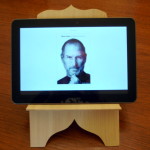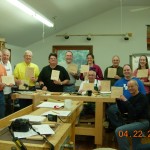A young scout was awarded his third rank a few evenings ago, the Wolf. The occassion needed a new neckerchief slide. Carved in basswood. Finished with acrylic colors topped with satin poly.
Young lad, enjoy being a wolf. Learn well.
Chocolate powered woodworking
We do some things just because they’re fun … or maybe a challenge.
 I have this brand new book. It needs a stand.
I have this brand new book. It needs a stand.
Ah-ha! Roy made a really interesting stand that’s originally attributed to Roubo. I call it a parlor trick because it is made from a single piece of wood. Roy made his from Walnut, probably near an inch thick. For fun, and challenge, I made mine from a scrap of boat lumber left over from Eva Won. It is cedar and rough resawed to about 1/2 inch thick. Can it be resawed thinner and tortured into becoming one of these bookstands?
The trick is making a barrel hinge and resawing right up to the edge of the hinge. Roy shows you how in this episode of The Woodwright Shop. Other than lumber and scale, mine isn’t much different … other than using a utility saw for resawing (hah!). Go watch Roy. I’ll let a few pictures tell the rest of the story.
There are very few woodcarvers teaching classical woodcarving in the U.S. Mary May is one of those few, and is also distinguished by being both a well experienced artisan, as well as a person with a wonderful teaching style.
Just because one is very skilled doesn’t mean they can teach well. Case in point was an experience with a trap shooter who has over half a million registered targets in his competition history. Yes, he can hit well, but when instructing others he barks out things like, “Well, you hit that one, but you didn’t deserve it.” or “Why did you do it like THAT!?”
Mary is just the opposite. Her skill is shown in short demonstrations that teach a particular technique. Then she sends people to their work and coaches them appropriately as they practice and absorb the technique. Easy going, enjoyable and effective!
 The weekend occasion was a “Beginners Woodcarving” class with Mary at Kelly Mehler’s fine school in Berea, Kentucky. Mary started us off with a “donut” exercise that quickly teaches one to sense and accommodate grain direction. Next was one of her favorites, the Camellia flower. After those, we moved to an acanthus leaf, linenfold, and a convex shell. The shell is moving well beyond “beginner” territory. In short, we covered a lot more than I expected. (No, I don’t have pictures of my own work … because not a single one of the projects was carried to completion, either in that class or yet.)
The weekend occasion was a “Beginners Woodcarving” class with Mary at Kelly Mehler’s fine school in Berea, Kentucky. Mary started us off with a “donut” exercise that quickly teaches one to sense and accommodate grain direction. Next was one of her favorites, the Camellia flower. After those, we moved to an acanthus leaf, linenfold, and a convex shell. The shell is moving well beyond “beginner” territory. In short, we covered a lot more than I expected. (No, I don’t have pictures of my own work … because not a single one of the projects was carried to completion, either in that class or yet.)
There’s nothing better than someone exceeding your expectations.
More info and pictures at Mary’s blog.